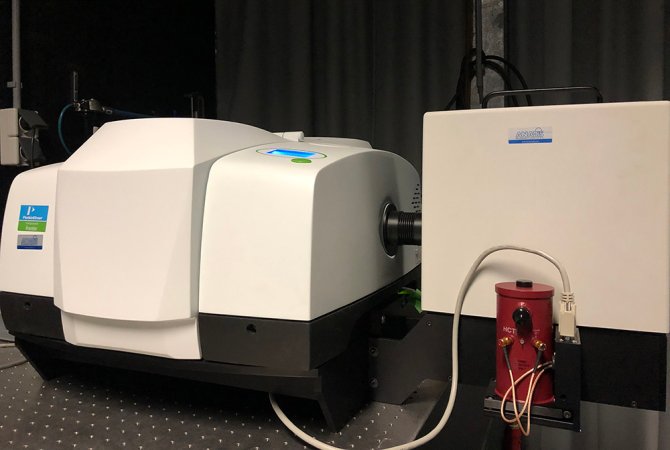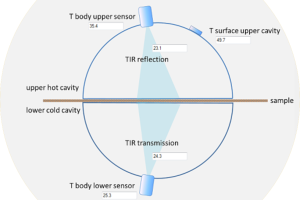
Measuring energy saving: thermal radiation, air permeability, moisture permeability
The energy saving capacity of a material is determined by the characteristics of the material itself, and by how it is used by a grower. The most important characteristics of materials are the transmissivity thermal infrared radiation and the emissivity.
Air and moisture permeability are also important factors for open materials such as screens and nets. That is the reason we develop special measuring equipment.
Emissivity meter
The extent to which a material can save energy depends on different factors including the transmission, reflection and absorption of thermal infrared radiation (TIR). The absorption of thermal infrared radiation is also referred to as emissivity. We have two devices for measuring these values: the Perkin Elmer Frontier FT-IR, and the Emissivity meter.
The Emissivity meter consists of two radiating hemispheres which are maintained at two different temperatures: one at room temperature, and the other at a higher temperature. Both hemispheres have a built-in infrared sensor. The material to be tested is placed briefly between the two hemispheres. The emissivity factor is determined from the difference in the measurements taken by the two built-in sensors. The transmission and reflection of thermal radiation can also be determined at the same time.
The large surface area of the Emissivity meter also makes it suitable for measuring shade cloths.
Perkin Elmer Frontier FT-IRTM
The Perkin Elmer Frontier FT-IRTM (Perkin Elmer Inc.) is a commercially available measuring device which can be used with an External Integrating Sphere (Pike Technologies) to measure the absolute and relative reflection of thermal infrared radiation (TIR). The measurement is taken for every wavelength where reflection occurs. The transmission and emissivity of thermal infrared radiation can be determined at the same time. The device is suitable for purposes such as measuring low emissivity (low-e) coatings on glass.

The internal optics of the External Integrating Sphere focuses the external bundle of the spectrometer in a 4-inch gold-plated integrating sphere. A gold-plated mirror is controlled through an external manual lever to manoeuvre it between the sample and reference position. In the sample position, incoming light enters at an 8° angle. This detailed spectral measurement can be very useful for R&D objectives.
Air permeability device
Determining the energy saving characteristics of screens requires us to understand not just the transmission, reflection and emissivity of thermal radiation, but also the permeability of air and moisture. The Air permeability device determines the convective heat flux through the material and is the main contributing factor in latent heat transfer.
This device measures the air permeability of screens, nets and other materials with air permeability. The velocity of air flow in greenhouses is often very low. That is the reason it was necessary for a suitable device to be developed from scratch, with its own software.
The device measures the air pressure differential (in Pascal) between the two sides of the cloth. The result can be applied to energy saving models or to the R&D process for new innovations.
Wet screen device
The measurement of screen characteristics is a rapidly developing field which is why Lightlab is continually designing new devices, for example to determine the air and moisture permeability and emissivity of wet screens.
